By signing his royal decree of June 29, 1835, Louis Philippe I, the King of the French, ceded to the Queen of Spain the original Foreign Legion formed in March 1831. However, faced with the growing need for troops in Algeria, the French government would soon order the formation of a new Foreign Legion. The first battalion was formed in 1836, closely followed by the four others, all created by 1840.
Having reached its regulatory strength, the new Foreign Legion in Algeria was split by order into two regiments on December 30, 1840. This decision would be implemented three months later.
La version française de cet article: Historique du 1er Régiment Etranger

1st Foreign Legion Regiment: 1841-1856
On April 1, 1841, the 1st Foreign Legion Regiment (1er RLE) was created, composed of the first three battalions of the Legion. This new regiment comprised about 3,000 men, commanded by Lieutenant Colonel Charles-Jacques de Mollenbeck, a former German officer. The 1er RLE was to operate against the Algerian rebel tribes in the provinces of Algiers and Oran, in the west of the country. The unit adopted the flag of the original Legion obtained in 1832.
Until 1847, the regiment conducted operations against the tribes of a certain Emir Abdelkader, as well as marches against Sharif Boumaza and his supporters. Then, taking advantage of a peaceful time, the men of the regiment focused their efforts on the construction of military posts and roads. In 1852, these occupations were interrupted by operations against the Beni Snassen, a rebellious Berber tribe.
At the end of the same year, the Second Empire of Emperor Napoleon III was established in France. Napoleon would then participate in the war against Russia, and in 1854, would send the French army, including the two regiments of the Legion, to Crimea. The legionnaires of the 1st Regiment were among the winners of the Battle of the Alma and took part in the siege of Sevastopol. Colonel Raphaël Vienot, their commanding officer, died gloriously at the head of his regiment in 1855.
In the meantime, the Emperor organized in France a second Foreign Legion, solely composed of Swiss citizens. Its short-lived existence would lead, at the end of the Crimean War, in 1856, to the transformation of these two Legions into new regiments. Thus, upon their return to Algeria, the two original Foreign Legion regiments merged to constitute a new 2nd Foreign Regiment (2e RE) in August 1856.



1st Foreign Regiment: 1856-1862
The two Legions were disbanded by the decree of April 16, 1856, to create two new foreign regiments. Thus, on June 26, 1856, the 1st Foreign Regiment (1er RE) was established in France with the men of the former 2nd Legion (Swiss Legion). Colonel Bonaventure Meyer took command of the new unit.
The new 1st Foreign Regiment, with a total strength of only 1,021 men, was sent to Algeria. The regiment took part in operations against the rebels in Kabylia, in the northeastern part of the country. By early 1859, most of the Swiss legionnaires’ unit — still nicknamed the “Swiss Legion” by the men of the 2e RE — had already been discharged, with only 500 men left.
Meanwhile, in Europe, a new war was arising in Italy, between France and Austria. In May 1859, the 1st Foreign Regiment landed in Italy and in early June, its 480 men fought bravely in Magenta alongside their comrades from the 2nd Regiment. In August, the 1er RE moved to Corsica where it remained until February 1860, to reorganize. The unit, composed of 2,600 men back then, was finally disbanded in Algeria two years later, in February 1862. At the same time, the original Legion, 2e RE, was redesignated the Foreign Regiment, Régiment Etranger.
As part of this new regiment, a number of men from the former 1st Foreign Regiment partook in the Second Franco-Mexican War, in 1863-1867. There, the legionnaires distinguished themselves by their heroism during the famous Battle of Camerone, on April 30, 1863.



1st Foreign Regiment: 1885-1895
After the Mexican campaign, the Franco-Prussian War of 1870-1871, the end of the Second Empire and the revolt in North-Algerian Kabylia, the Foreign Regiment regained the name Foreign Legion in 1875. In the early 1880s, the legionnaires faced the partisans of Cheikh Bouamama before the first units of the Legion were sent to the Far East.
On January 1, 1885, following a new split, two regiments were reborn. The 1st, 2nd and 5th Battalions merged to form the 1st Foreign Regiment, under the command of Colonel Paul Grisot. With HQ in Sidi Bel Abbès, two of its battalions were engaged in Tonkin (the northern part of present-day Vietnam), Indochina, against China. They notably took part in the sieges of Tuyeng Quang and Langson. In June 1885, a peace treaty put an end to the war. Two years later, French Indochina was created. Regularly relieved, the legionnaires of the 1st Foreign Regiment would remain there until 1930.
A depot company of the regiment, comprised of more than 1,000 men, was responsible for the administration, recruitment and training of enlisted volunteers in Algeria. The music band was also attached to the 1er RE, which obtained its new regimental flag in July 1885.
The new 3rd and 4th Battalions, formed in Algeria by dividing the former 5th, were to be actively distinguished in the desert of South Oran (then a partially unpacified region located along the Moroccan border, southwest of Sidi Bel Abbès) and during the occupation of the Saharan oases in the 1880s, 1890s, and 1900s. At the same time, the first light infantry units equipped with mules were formed – mounted companies. A new 5th Battalion was constituted in 1891.
While the regiment continued to pacify Algeria, it also participated in different operations in French West Africa, including the Second Franco-Dahomean War (in present-day Benin) against King Béhanzin from 1892 to 1894, where Major Faurax was killed at the head of his legionnaires. Meanwhile, the men of the 1er RE were also involved in the campaign in West Africa’s French Sudan (now Mali) against Sultan Samory and his troops.



1st Foreign Regiment: 1895-1914
From 1895, the men of the regiment were involved in the conquest of Madagascar, in the ranks of a battalion of the Legion. Over 200 legionnaires would perish there due to the climate and fatigue. Nevertheless, in 1896, the kingdom was successfully abolished and Madagascar became a French colony. Thereafter, the pacification of the island began for the men of both foreign regiments. Once again builders, they would leave behind important and original installations. The pacification continued until 1905, when the last legionnaires stationed on the island returned to Algeria.
In 1899, following the 1898 Fashoda Incident, 1er RE men arrived in Tunisia, which had been occupied by France since 1881, to face the anticipated forces coming from Malta.
In 1906, the government awarded the 1st Foreign Regiment with the Legion of Honor, the highest French order of merit. Three years later, the Italian city of Milan awarded the regiment’s color with its gold medal, in memory of the 1859 campaign.
Facing attacks against its nationals and confrontations in the Algerian-Moroccan borderlands, France decided to intervene in Morocco. Therefore, in August 1907, the legionnaires of the 1st Foreign Regiment led the assault troops with the 6th Battalion, formed in 1899. Their commander, Major Provost, became the first Foreign Legion officer to be killed in Morocco.
In early February 1908, a company of the regiment was decimated by a furious snowstorm near Forthassa in South Oran, at the Moroccan border. The same year in this same region, the 1er RE’s 24th Mounted Company resisted numerous enemy attacks in Bou Denib.
In 1912, the French protectorate treaty over Morocco was signed, thus launching the country’s pacification. The Legion, including the units of the 1st Foreign Regiment, played an important part in the pacification by forming in Morocco a three-battalion regiment combat team (Régiment de marche, RM), supported by two 1er RE mounted companies.






1st Foreign Regiment: 1914-1919
Soon, Europe started to prepare for an anticipated war. In addition to the 10,000 pre-war legionnaires, more than 10,000 foreigners volunteered for the duration of the war. With them, the 1st Foreign Regiment would establish in France three regiment combat teams to fight on the Western Front — the 2nd in August 1914, the 3rd in September, and the 4th in November. Neuville-St-Vaast, in April 1915, and Souchez-Carency, in May of the same year, marked the action of the short-lived 2e RM, while the 4th, the “Garibaldi Legion,” did wonders at Bollants Wood in mid-January 1915. Cruelly tested, these units were deactivated and merged into one, giving birth to the prestigious RMLE, the Foreign Legion Regiment Combat Team. Holder of nine mentions in dispatches and the double fourragère, its flag became the most decorated in France in 1918.
The war was also raging in the Dardanelles, Serbia, and Macedonia. Two companies of the regiment took part there within the Foreign Legion Eastern Battalion that successively opposed the Turks and the Bulgarians.
Spread across all the fronts of the Great War, the 1st Foreign Regiment had to maintain a French presence in Morocco, Tonkin, and South Oran as well, despite significant difficulties.
1st Foreign Regiment: 1920-1939
At the end of the war in Europe, the Legion was reorganized. The 1st Foreign Regiment, whose troops were tremendously reduced by all the fights, was completely reformed in 1921. Its three old battalions staying in Morocco formed a new unit, the 4th Foreign Regiment, in late 1920. At the same time, Lieutenant Colonel Rollet‘s RMLE, also stationed in Morocco, became the 3rd Foreign Regiment. In 1925 in Sidi Bel Abbès, the famous officer took command of the then 1st Foreign Infantry Regiment (1er REI, renamed since 1922), which he commanded until 1931, the important year of the Legion’s “Centenary” and the unveiling of the remarkable War Memorial.
Unfortunately, a tragic event occurred in September 1932, when dozens of 1er REI legionnaires were killed in the derailed train near Turenne, in northwestern Algeria, on their way to Morocco.
Nevertheless, regardless of this tragedy, the 1930s would become the golden age of the Legion. The 1er REI continued to carry out its tasks. The regiment acted as a marvelous combat instrument, as well as a gigantic enterprise responsible for the administration and training of the Legion’s entire staff and legionnaires. Combining the strength of some 10,000 men, it left its mark in Morocco, Algeria, Tunisia, Tonkin, and recently, in the Levant (Syria and Lebanon), participating in the pacification of the region.
Besides, four of its battalions (1st, 2nd, 6th, 7th), alongside two sapper-pioneer companies and an artillery platoon (equipped with 80 mm guns), distinguished themselves in the ongoing operations in Morocco, mainly in the north of the country – in the Rif War of 1925-1926. The Automobile Company (a former mounted company of the 2e REI, newly motorized), alongside men from the Algerian Mounted Company (CMA), partook in the 1933 Battle of Bou Gafer at the Djebel Sagho, and in the Anti-Atlas campaign in 1934, which successfully achieved Morocco’s pacification.
That year, the 1er REI’s Sapper-Pioneer Company (CSP, created in 1922) and the CMA deployed to eastern Algeria to help suppress the riots which affected the region between July and August. The 3rd Battalion reinforced them in 1935.
In the meantime, four battalions of the regiment stationed in Tonkin gave birth to a new unit, the 5e REI, constituted in 1930. In Syria and Lebanon in 1939, three other battalions of the 1er REI formed the 6th Foreign Infantry Regiment. In July of the same year, 1er REI legionnaires paraded in Paris, for the very first time with their white kepis.
At that time, on the eve of the Second World War, the regiment comprised seven operational battalions (each consisting of a HQ, three combat companies and a support company), a training battalion, a transit battalion and a depot in France to receive foreign volunteers enlisting for the war period. By the way, the 5th Battalion (re-created in Algeria in 1936) was to be organized as a motorized unit; however, it is unclear if the objective was eventually achieved.
In addition, there were several smaller, special, autonomous units serving in North Africa, also assigned to the 1er REI. In Algeria, there was a sapper-pioneer company, an automobile company, a motorized company (in fact, the former CMA, motorized in the mid-1930s), a disciplinary company stationed in South Oran, and a motorized Saharan battery formed in 1938 (yes, already in 1938 and not in 1939, as official historical works tell us). In Tunisia, two obscure, rather mysterious units of the 1st Foreign Regiment were posted there: the 19th Autonomous Company and the 66th Southern Company. Nowadays, we don’t know anything about their mission.
In late 1939, the five years of peace for the Legion, marked by training, construction works, maneuvers, patrol tours and unit modernization, were over. Once again, Europe was set ablaze by an upcoming struggle.





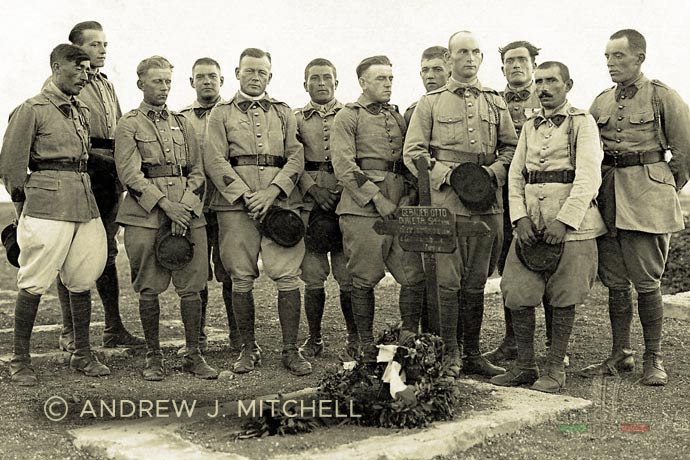



1st Foreign Regiment: 1939-1943
In early September 1939, the Legion was 23,000 men strong. Thereafter, some 20,000 foreigners once again volunteered for the duration of the war to defend their adopted country. To operate in Europe, mainly on France’s Western Front, the provisional regiments and a demi-brigade with numbers 11, 12, 13, 21, 22, and 23 were organized, with the participation of officers, non-commissioned officers, and legionnaires coming from the 1er REI. Following the painful armistice, the survivors were regrouped during the summer of 1940 in the Aubagne region (a curious predestination) and returned to Algeria, where the 1st Foreign Regiment continued its work and prepared for the resumption of fighting.
At the end of 1940, the Automobile Company became fully autonomous and was redesignated as a Saharan company (future 1re CSPL).
In mid-1941, a demi-brigade was constituted with two battalions of the regiment to be deployed to Senegal, French West Africa, where it became the 4e DBLE. A few months later, the 1er REI was reinforced by two battalions of the 6e REI that had to leave the Levant. In April 1942, the Foreign Regiments Joint Depot (DCRE), which had been in charge of the Legion’s personnel administration and military training since 1933, was completely separated from the 1er REI and became an independent, regiment-like unit.
At the beginning of 1943, when the French Army of Africa resumed fighting against Germany, a battalion and a motorized company of the 1st Foreign Regiment were engaged in Tunisia, where the legionnaires were slowing down a heavily armed enemy. In April, the arrival on the Tunisian front of the two 4e DBLE battalions from Senegal permitted the creation of the 1er REI de Marche (1er REIM, regiment combat team) before being integrated into a new RMLE. The latter, between 1943 and 1945, maintained the reputation of its glorious elder brother during fights in France, Germany, and Austria. Thus, due to a lack of manpower, the 1er REI was deactivated in Sidi Bel Abbès in late June 1943.


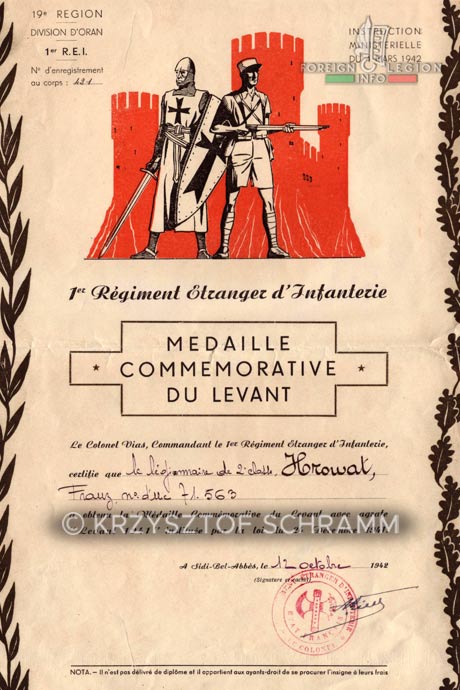
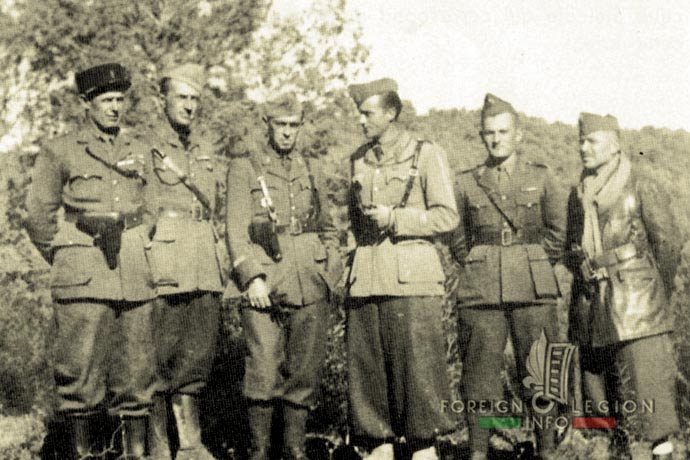
1st Foreign Regiment: 1946-1962
Re-created in May 1946 to serve in Tunisia as a single autonomous battalion, the 1st Foreign Infantry Regiment changed its name again and became a new 6e REI on April 1, 1949. But the same day in Sidi Bel Abbès, the independent DCRE ceased to exist and transformed into the new 1er REI.
Considered the “reservoir” of men and the school that trained their cadres and specialists, the 1st Foreign Regiment was a formidable “soldier factory” for the First Indochina War (1946-1954), where a battalion of the regiment would even operate in 1950. Four transit companies welcomed both young recruits and officers destined to join the units serving in French Indochina. In the meantime, three instruction centers provided accelerated training adapted to the extraordinary needs of the ongoing war against Ho Chi Minh‘s Viet Minh.
Besides, a little-known engineering unit was created in late 1949 within the 1er REI. Its purpose was to reinforce the legionnaires during a new campaign in Madagascar. It remained on the island until the end of 1951, to build roads and bridges there.
Following the end of the war in the Far East, the Legion units returned to North Africa, where the 1er REI pursued its mission. In 1954, the insurgencies in Morocco, Tunisia, and Algeria forced the regiment to become once again an operational unit and set up task forces to restore order in the affected regions. Meanwhile, a new 6th Battalion composed of three motorized companies of the future GPLEA was to be established.
In 1955, the 1er REI became the 1st Foreign Regiment again and continued its dual mission of administrator and instructor. Its Training Group (GILE) trained young recruits as well as future paratroopers and cavalrymen.
During the Algerian war of 1954-1962, the regiment also participated in operations to defend the country it had helped build. These operations cost the rebels 613 dead and 548 prisoners, while 63 legionnaires of the 1er RE were killed in action, and 136 were wounded throughout these nine tragic years. In addition, nearly a thousand weapons were seized by the 1er RE men. Nevertheless, despite all these efforts, the political situation deteriorated, and Algeria was lost. In October 1962, the “Motherhouse” of the Legion had to leave its old garrison town and its homeland, and relocated to France.







1st Foreign Regiment: 1962-1984
On September 29, 1962, the remains of General Rollet, Prince Aage of Denmark, and Legionnaire Zimmermann – the last legionnaire of the 1er RE killed in Algeria – were transferred to Provence, where they now rest.
In the meantime, the legionnaires had taken possession of an abandoned camp in Aubagne, in the Marseille region, to build new headquarters worthy of the Legion, while the GILE training companies moved to Corsica.
Dismantled in September 1962, the famous War Memorial would be re-erected in Aubagne, on the new parade ground of the Quartier Vienot, and unveiled on April 30, 1963, the Centenary of the Battle of Camerone.
As the guardian of the Legion’s traditions and glories, the 1er Etranger would continue to proudly preserve the old relics and would build a museum, completed in 1966.
As was always the case, the regiment once again provided an operational unit, after the deactivation of the little-known Intervention Company in August 1963. Thus, in early 1968, it formed the last Foreign Legion unit stationed in Algeria, the Company Team (Cie de marche), based in Bou Sfer until July. The following year, it formed the Motorized Company, set to operate in Chad until 1970 alongside the legionnaires of the 2e REP. Finally, in Corsica in 1971, the 1er RE organized an operational task force: Foreign Legion Operational Group (GOLE).
However, the regiment was still in charge of construction tasks. That’s why it created, in early 1968, a company of pioneers to participate in the construction of the largest military shooting range in Western Europe, Canjuers Camp. Two years later, this company would be incorporated into the 61e BMGL.
Ten years after its arrival in Aubagne and Corsica, in 1972, the regiment split up and attributed to the freshly reconstituted 2nd Foreign Regiment in Corsica the missions of training recruits and legionnaires and maintaining the role of an intervention unit available to serve anywhere and anytime.








1st Foreign Regiment: 1984-2021
In 1984, a reform affected the French Army. To strengthen the Legion in mainland France, the men of the 1er RE’s reinforced road construction company (CRTRLE, 1978-1984) formed the core of a new engineering regiment, the future 1er REG. That same year in Aubagne, in the regimental headquarters, the organization of the Legion’s structure was formalized with the creation of the Foreign Legion Command, COMLE.
From then on, the 1st Foreign Regiment has been responsible for carrying out the Legion’s common services. In other words, it manages all the personnel of the Legion and supports administratively the COMLE which the regiment is subordinated to. The 1er RE is also in charge of the conservation of the Legion’s traditions and historical heritage. Besides, it operates the different cells in charge of the assignment, reenlistment, regularization, naturalization, or reconversion of all personnel serving as foreigners. At the same time, the regiment takes care of its handicapped veterans by allowing them to live with dignity at the Veteran Institution (IILE), in Puyloubier, not far from Aubagne.
The 1st Foreign Regiment represents the Foreign Legion, for example, through its Band, Pioneer Platoon, or Kepi Blanc Magazine. The Legion Museum and the Documentation Center (in charge of the historical archives) are assigned to the regiment as well.
Each legionnaire starts his career at the 1st Foreign Regiment, returns to it when he leaves basic instruction, and comes back each time he changes assignment, as well as at the end of his active service for the discharging formalities.
The regiment was also responsible for recruiting (until 2007), selecting, and incorporating volunteers (until January 2020) before sending them to basic training in Castelnaudary. These tasks are now carried out by the Recruiting Group (GRLE).
To support operations abroad, the 1er RE specialists often reinforce other units of the Legion. In 1983, a detachment of the regiment participated in the missions of the international peacekeeping force in Lebanon. In 1990-1991, some 150 men of the regiment were deployed to Operation Daguet, as part of the Gulf War. These days its legionnaires are involved in missions in France as well, in particular the anti-terrorist Operation Sentinelle.
Awarded the War Cross of the Foreign Theaters of Operations with the blue-red Fourragère in April 2019, the long and prestigious history of the 1st Foreign Regiment, the Legion’s Motherhouse and its oldest unit, continues today…
1st Foreign Regiment in images: 1841-2021












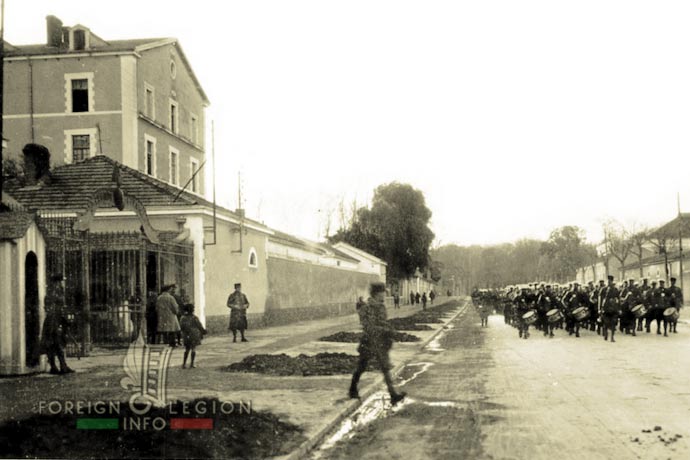









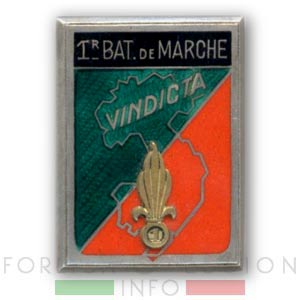









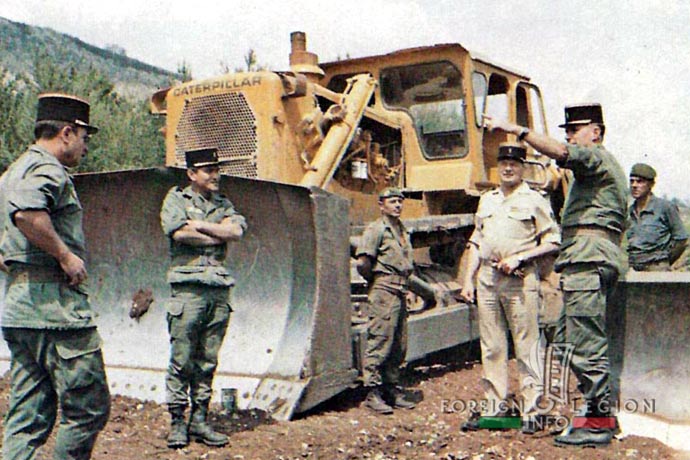










———
My special thanks belong to Krzysztof Schramm, for sharing his rare photos and documents with all of us.
———
Main information sources:
Képi blanc magazines
Légion Etrangère magazines
Foreign Legion annual bulletins (1950s, 1960s)
P. Cart-Tanneur + Tibor Szecsko: La Vieille Garde (Editions B.I.P., 1987)
Pierre Soulié: Paul-Frédéric Rollet : Père de la Légion étrangère (Editions Italiques, 2007)
J. Brunon, G.-R. Manue, P. Carles: Le Livre d’Or de la Légion Etrangère (Charles-Lavauzelle, 1976)
Alain Gandy: La Légion en Algérie (Presses de la Cité, 1992)
Jean Hallo: Monsieur Légionnaire (Lavauzelle, 1994)
Tibor Szecsko: La Légion étrangère en Indochine 1914-1941 (Edi-cats, 1989)
by Collective: Historique des unités de la Légion étrangère pendant la guerre 1914-1918 (Maroc et Orient) (D. Heintz & Fils, 1922)
Pierre Dufour: Génie-Légion (Lavauzelle, 2000)
Memorial Gen Web (Fr)
Fanion Vert et Rouge (Fr)
Wikipedia.org
———

You can support this website at any time through our store. Thank you.
EU-based readers can visit our EU-based shop, to avoid import charges.
—
Learn about other Foreign Legion’s regiments:
1st Foreign Parachute Regiment
2nd Foreign Cavalry Regiment
3rd Foreign Parachute Regiment
4th Foreign Infantry Regiment
5th Foreign Regiment
6th Foreign Infantry Regiment
Foreign Regiments Joint Depot
12th Foreign Infantry Regiment
—
The page was updated on: April 28, 2021
